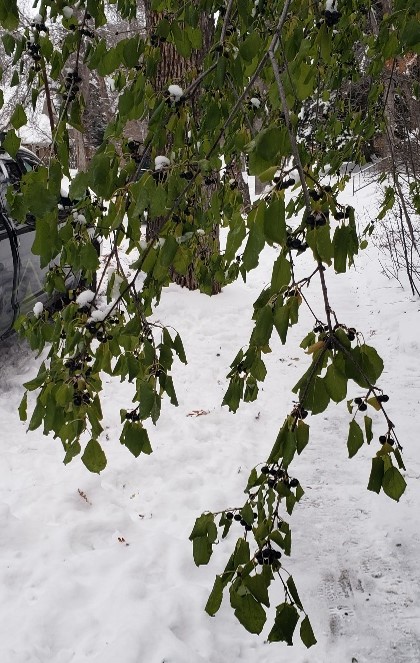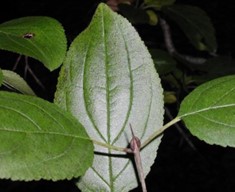Common Buckthorn (Rhamnus cathartica)
Introduction

Common buckthorn branch overhanging sidewalk on a snowy afternoon in Bozeman, MT. Photo by Jane Mangold, MSU.
Walking home on a snowy afternoon in November, I was struck (literally and figuratively) by a small tree still holding on to its green leaves while nearly all the other trees and shrubs in the neighborhood were bare or their leaves were brown. Low and behold, the tree was common buckthorn, prompting this weed post which once again highlights this invasive plant (see February 2015 Monthly Weed Post). Common buckthorn was introduced to North America for its medicinal qualities and became widely naturalized in the 1800s due to its extensive use in hedgerows. It is a noxious weed in several other states in the upper Midwest and Northeast and was placed on the Montana noxious weed list in 2017.
Identification and Biology

Close up of common buckthorn branch. Notice dark purple berries. Photo by Jane Mangold, MSU.
Common buckthorn grows 6 to 25 feet tall. Twig tips usually have short, sharp thorns. Leaves are oval, glossy, dark green and stay attached until late fall. Leaf veins are distinctive in that they occur as pairs, typically 3 to 6, and curve toward the tip of the leaf. Common buckthorn is dioecious, meaning there are male and female plants; only female plants produce fruit, which are purplish-black berries. Watch a video comparing features of common buckthorn to chokecherry, a similar looking native species that common buckthorn can be mistaken for; this video is part of the MSU Extension’s playlist “Noxious Weed or Native Plant?”
Habitat

Glossy green leaves and thorn-tipped twig. Photo by Leslie J. Mehrhoff, bugwood.org.
In my experience, I have typically seen common buckthorn in the understory of deciduous forests, especially along streams and rivers. However, it can also be found along fence rows, in pastures and abandoned fields, and roadsides. Because it was intentionally planted for decades, it is more common in urban environments and nearby woodlands than it is in less disturbed areas like wild lands.
Management
Survey for common buckthorn in the late fall because it is easy to see amid other vegetation, and flag plants for treatment either then or later. Because common buckthorn is dioecious, focus on controlling female plants, especially if the infestation is sizeable or the risk of injury to other understory vegetation is high. Successful management of common buckthorn usually requires a combination of mechanical and chemical control. Cut-stump + herbicide treatment or basal bark treatments should be used on plants with large diameter stems; hand pulling, mowing, or foliar herbicide treatments can be used on smaller plants. See the MSU Common Buckthorn MontGuide for information on management as well as other notes on identification, biology, and ecology.
Further Information
For more information about this month's weed post, contact Extension Invasive Plant Specialist Jane Mangold. Past posts are available in the Monthly Weed Post Directory.
This weed post is also available as a printable PDF (827 KB).
